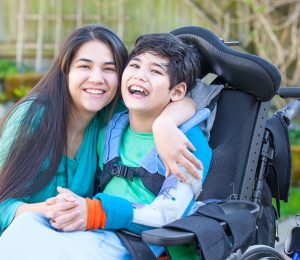Author Niki Sung is the mother of three children, two with disabilities. She was an educator for 10 years, teaching children with disabilities and students in low-income communities. She is the owner of Optimal Academics, a tutoring company for students with learning disabilities and specific learning needs.
If you’ve found yourself stumbling over the right words or how to talk to your children about people with disabilities, know that you are not alone. It is a challenge, and the language we use does make a difference.
Here are some guidelines for using the “right” language about disabilities when talking to kids.
Understanding Disabilities
Understanding the language to use requires some understanding of what disabilities are, and what they are not.
Broadly defined, a disability is any limitation in activity that may prevent someone from learning, participating, or interacting like his or her peers. So, a person with a disability requires some type of intervention, whether it be educational, medical, or the use of a mechanical device.
People with disabilities are not broken or unable to learn, even though they may not be able to fully participate in every activity. It’s also important to recognize that the spectrum of disabilities is diverse and wide-ranging, encompassing non-visible and visible disabilities, temporary and lifelong disabilities, and disabilities of varying degrees of severity.
Here are some examples of disabilities:
- someone who is paralyzed and needs to use a wheelchair (mechanical device)
- someone who is hard of hearing and needs to use a hearing aid (mechanical device)
- someone with dyslexia who requires the use of audiobooks to fully comprehend the text (educational)
- someone with autism who requires the use of speech to text software to help them write a cohesive essay (educational)
- someone with ADHD who may take medication to decrease hyperactivity and impulsivity (medical intervention)
- someone with anxiety who may receive cognitive behavioural therapy (medical intervention)
So, What Should I Say?
I am by no means the expert and how we describe things are changing all the time—especially when describing people with disabilities.
However, the most important thing to remember is that the person comes first and the disability comes second. People with disabilities are people first. Refer to a “person with a disability” rather than a “disabled person”. And it’s best to name the specific disability if you aware of it, rather than using a more generalized term like “disabled”.
Of course, language that is demeaning or disrespectful to the individual is never appropriate: retarded, slow, and crippled, for example, are obviously unacceptable.
Language that stigmatizes the individual should also be reworded:
- Confined to a wheelchair becomes uses a wheelchair
- Suffers from epilepsy becomes has epilepsy
In all cases, only refer to a specific disorder if you are aware of a person’s actual medical diagnosis. When in doubt, ask: “How do you like to be identified?”
Here are some terms you might use:
- people with disabilities — rather than disabled people or the disabled
- specific learning disability refers to a wide variety of learning disabilities, like dyslexia
- hard of hearing — as opposed to hearing-impaired
- intellectual disability refers to problems with intellectual and adaptive functioning, traditionally identified by an IQ score of 70 to 75 or lower (though today IQ tests are no longer required for diagnosis)
- visible disability is a disability that can be seen (a person with quadriplegia has a visible disability)
- non-visible disability is a disability that cannot be seen (a person with epilepsy or a mental health disorder has a non-visible disability)
- accessible parking — rather than handicapped parking
- a person with Autism Spectrum Disorder (ASD) or a person on the autism spectrum — rather than an autistic person
A Note about the Word “Normal”
Avoid the word “normal”. It is a hurtful term that implies something is wrong with the individual. People with disabilities are just as normal as people without disabilities.
To read more regarding appropriate terms, consult the National Disability Authority’s Appropriate Terms To Use and this detailed Disability Terminology Chart from the Judicial Council of California.
Remember, each person is an individual and there is no one-size-fits-all solution. For example, in this article, Madeleine Ryan explains why she prefers to be called autistic rather than a “person with autism”, even though it’s not considered politically correct.
Noticing the ways we use language surrounding disabilities may seem like a daunting task. You may even think it is pointless to try. But language and the words we use affects people and affects our perceptions of people in our culture.
Bottom line: you won’t always get it right. Language norms are always evolving and some individuals prefer certain terms over others. But it’s not about saying the right thing every time—it’s about trying, it’s about listening, and it’s about learning, together.
A version of this post was originally published by Optimal Academics, a Toronto-based tutoring company for students with learning disabilities and other specific learning needs.




